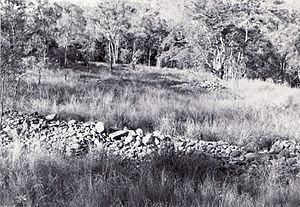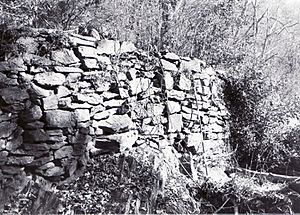Stonyville Township facts for kids
Quick facts for kids Stonyville Township |
|
|---|---|

Stonyville, 1994
|
|
| Location | Mareeba Mining District, Palmer, Shire of Cook, Queensland, Australia |
| Design period | 1870s - 1890s (late 19th century) |
| Built | 1870s - c. 1900 |
| Official name: Stonyville Township, Water Race and Cemetery, Stony Creek Township | |
| Type | state heritage (archaeological) |
| Designated | 21 October 1992 |
| Reference no. | 600433 |
| Significant period | 1870s-c. 1900 (historical) |
| Significant components | other - mining/mineral processing: component, cemetery, trees/plantings, water race |
| Lua error in Module:Location_map at line 420: attempt to index field 'wikibase' (a nil value). | |
Stonyville Township, Water Race and Cemetery is a special historical site in Queensland, Australia. It is located in the Mareeba Mining District, near the Palmer River. This place includes the remains of an old mining town, a long water channel, and a cemetery. It was built between the 1870s and around 1900. Today, it is protected as a heritage site because it tells an important story about gold mining in Queensland.
Contents
The Story of Stonyville
Stony Creek is one of many small streams in the Limestone area, south of the Palmer River. In 1874, James Venture Mulligan found gold in Sandy Creek, which led to a big gold rush. Many Chinese gold miners came to this area, including Stony Creek, to search for gold in the river gravels. They found a lot of fine gold for several years.
It is not clear exactly when gold mining started at Stony Creek. However, it was likely during the gold rush of 1874. A small town grew up on the south side of a wide bend in the creek. By 1882, the town had a hotel run by Len Yue, butcher shops owned by John McLean and Sam Marris, and several Chinese stores.
In September 1896, a government geologist named Robert Logan Jack visited "Stony Creek Township." He noticed that the town was much smaller than before. He wrote that there were only four houses left, plus a few huts. All of them were lived in by Chinese people. He also saw a very impressive water channel, or "water race," which he thought must have been very expensive to build. This water race shows how skilled the Chinese miners were at building things.
Before the Chinese miners arrived in large numbers, European gold seekers had found "fantastic amounts" of gold here. Later, the Chinese miners were known to be very successful at Stony Creek. This explains why they were still there when Jack visited in 1896, and why there is a Chinese cemetery. It is believed that the area was completely abandoned in the early 1900s.
What Stonyville Looks Like Today
The old town and cemetery are on a flat, open area next to a horseshoe-shaped bend in Stony Creek. A new road has been built through the middle of the town. This road leads to a large area where miners dug into the hillside.
Today, most of the buildings in Stony Creek township are gone. What remains are mostly archaeological clues. These include stone surfaces, rock-lined areas, and stone cooking places. There are also two small groups of mango trees, which might have been planted by the people who lived there.
The cemetery is right next to the town on the northwest side. Its edges have recently been marked with four corner posts. When the area was surveyed, it was covered in long grass. Only two disturbed piles of stones were visible, which might have marked the cemetery's boundary. It is believed that the cemetery has the footstones of 15 graves. Some grave markers were taken away for safekeeping by a local historical society.
The water race is about 1,000 meters long. It runs along the northern and eastern banks of Stony Creek. For most of its length, the race is a channel about 1 to 2 meters wide. It was partly dug into the solid rock. In some places, it was built up on a mound of rocks and earth, reaching up to 6 meters above the creek bed. Some parts of the race have strong stone walls, about 1 to 2.4 meters high, to hold the water. The race also cuts through solid rock for about 20 meters in a narrow gorge. The water race ends at an area where gold was mined from the creek, right next to the Stonyville township.
Why Stonyville is a Heritage Site
Stonyville Township, Water Race and Cemetery was added to the Queensland Heritage Register on October 21, 1992. It meets several important standards to be listed as a heritage site.
A Glimpse into Queensland's Past
This place is important because it shows how Chinese settlers and gold miners worked in a tough, faraway part of North Queensland. It helps us understand the history of mining and settlement in the state.
A Rare and Special Place
Stonyville is a unique and well-preserved example of a mining site. It has a water race, old stone dams, creek mining areas, the town site, and a cemetery all together. It is the best surviving example of this type of place in Queensland.
Learning from the Past
Because it is so well-preserved, Stonyville has the potential to teach us a lot about Queensland's history. Studying this site can help experts understand more about the people who lived and worked there.
Showing What Mining Sites Were Like
This site clearly shows the main features of historical mining places. The combination of the water race, dams, mining areas, town, and cemetery makes it a great example of its kind.
Beautiful Scenery
The area also has strong visual qualities, meaning it is a beautiful and interesting place to see.


